Clevo P750ZM: GTX 980M Overclocking Investigated
by Jarred Walton on March 20, 2015 10:00 AM ESTClevo P750ZM: Overclocking Performance
There are a couple things we want to look at with the overclocking results. First is average frame rates, naturally, but we also logged minimum frame rates and averaged the bottom 3%. The third thing we wanted to check is power draw, which isn’t as precise a measurement as we just looked at a Kill-A-Watt meter while the tests were in progress and noted the typical maximum power used. Let’s start with the frame rates before moving on to power requirements.
Note that our overclocks (counting GPU Boost clock speeds) generally work out to a 12% core OC and 10% RAM OC with +135/+250, while +250/+400 is a 22%/16% core/RAM overclock. That means with GPU limited settings we should see performance improve by around 10% with the moderate OC and perhaps as much as 20% with our “maximum stable” OC.
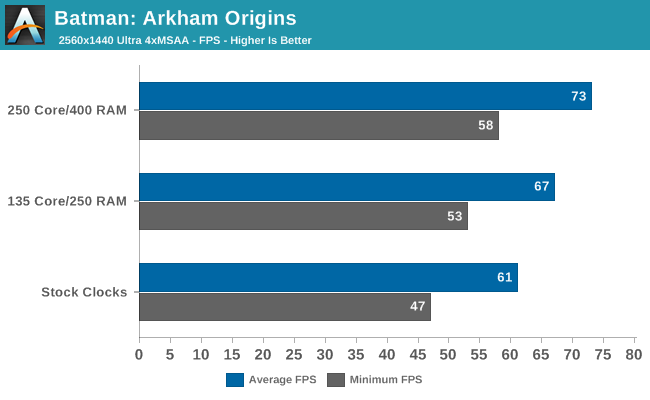
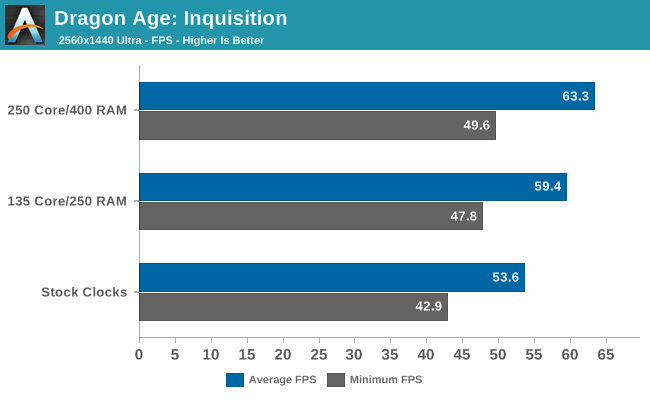

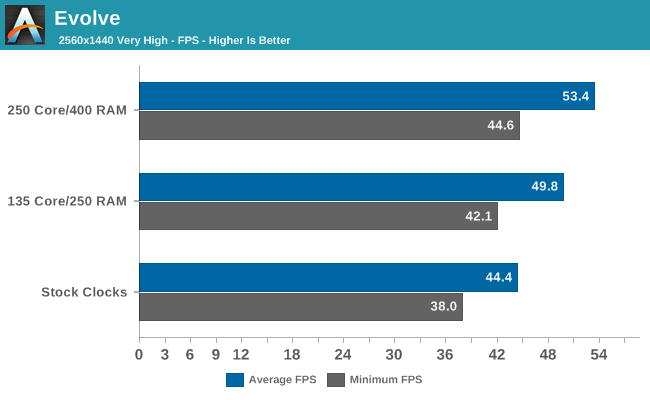
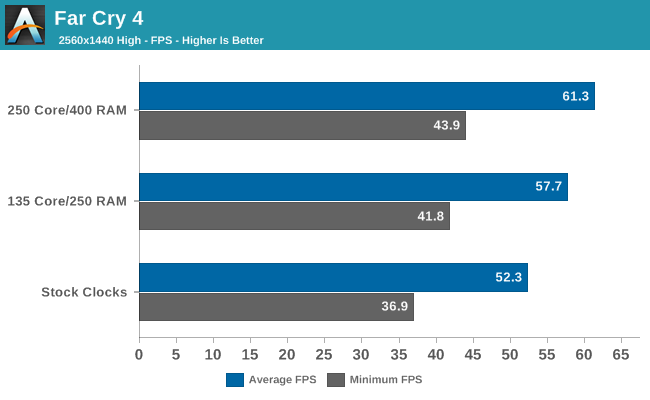
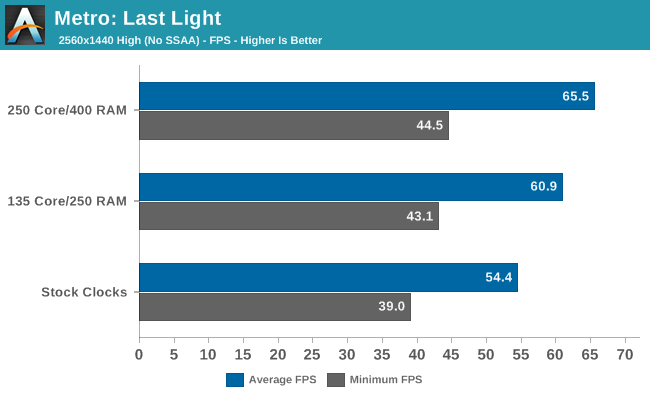
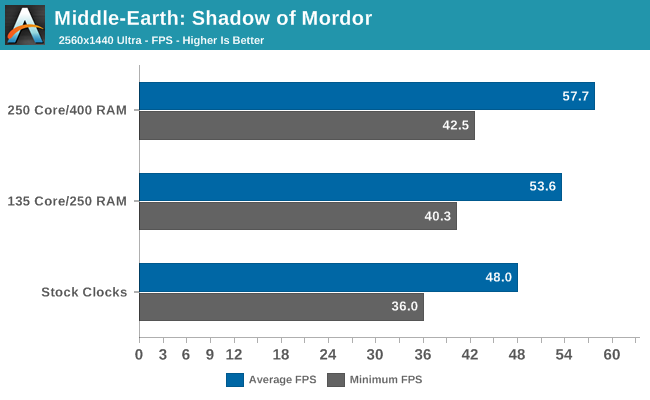
All of the games we selected are certainly playable at our selected settings without any overclocking, but with the exception of Batman: Arkham Origins none of the games average over 60FPS. That means you’re stuck with choosing lower quality settings and/or disabling VSYNC in order to improve the gaming experience. We test without VSYNC of course, but that results in image tearing which is generally undesirable – and that’s why for actual gaming we like to get 60+ FPS and turn on VSYNC. Our hope was that with some overclocking, we could push a few of the games over that barrier, and we did manage to succeed in several cases…barely.
Batman of course stays above 60 FPS, and now even the minimum FPS is very close to 60, which is what we want for an ideal gaming setup on a 60Hz display. Dragon Age, Far Cry 4, and Metro: Last Light also average over 60, and Dying Light is very close to 60, but the minimum FPS is in the 45-50 range, so VSYNC would result in some areas showing some stutter. The other titles – Evolve and Shadow of Mordor – are still very playable, but if you’re gunning for 60+ FPS you’ll need to drop the settings a bit (which is easy enough to do).
On average across the seven games we tested, the moderate OC improves average performance by nearly 11% and minimum FPS by just over 11%, so we’re very close to the theoretical maximum improvement, and it looks like most of the games benefit from additional shader performance rather than more memory bandwidth.
The more aggressive overclock shows similar scaling, improving average FPS by almost 19% and minimum FPS by almost 17%. While that might not seem like that much of an increase in performance, the GTX 980M is only about 25-30% faster than the GTX 880M, so really we’re looking at nearly a full generational improvement in performance.










34 Comments
View All Comments
CrazyElf - Friday, March 20, 2015 - link
To be honest, laptops probably don't have the margins for overclocking that a desktop would.For the desktop CPU, it is already pretty hot to begin with. You might be able to knock 15-20C down by delidding that 4790k, much like a desktop. The problem is, with a desktop you can use a giant cooler like the Noctua D15, or water cool. You cannot with a laptop.
GPUs have similar problems. Large triple slot coolers and water blocks are available - indeed they are made specifically for desktop overclocking. There's no way to do that in a laptop. It just isn't possible.
Khenglish - Friday, March 20, 2015 - link
Did you see the GPU temps? With a 20% overclock it only reached around 77C, which is cooler than many stock coolers on similar desktop cards.CPU temps are bad though. I think the problem is that clevo went with a combined GPU/CPU heatsink for this laptop, which is something they have not done before. While this sounds good at first, it makes having good die contact on both CPU and GPU nearly impossible without a large amount of flex in the heatsink, which the P750ZM heatsink does not have.
CrazyElf - Friday, March 20, 2015 - link
Apples to oranges. Maxwell is a pretty cool running chip on desktops too. If you are comparing the 980M to the AMD 290X, then yes, the desktop chips are hot in comparison. But remember, we should be comparing the 980M to a desktop Maxwell, and this is a chip that has 1/4 of the units stripped (so 1536 out of 2048 active) compared to the desktop part, which is already pretty cool running.A delid as I said might solve the problem partly like in desktops of the 4790k, but either way, there isn't much OC headroom in that chip even with the delid.
To be honest, the GT72 is a better choice IMO:
http://www.anandtech.com/show/8694/msi-gt72-domina...
The CPU runs cooler and the battery life is better, should you ever need it. It is somewhat slower, but not by much. Plus newer versions with an IPS screen are available - I just wish Anandtech had reviewed it with the IPS screen.
I just wish that instead of overclocking, that a full 2048 version of the 980 were available, running at a lower clockspeed. My wet dream would be the big 3072-Titan X die severely underclocked on a laptop, but that would never happen for various reasons.
Khenglish - Saturday, March 21, 2015 - link
Yeah full 2048 would rock. I am 100% convinced that the only reason it just has 1536 running is so Nvidia can release a fully enabled chip in the future and say they have a new, faster card.JlHADJOE - Saturday, March 21, 2015 - link
Actually, looking at the combined CPU and GPU temps, it's pretty obvious that system is more or less maxed out thermally.The CPU is pegged at 95-99C, and the GPU is similarly pegged at 77C. When the GPU clock is raised is that the CPU clock goes down, so "overclocking" here merely trades CPU clocks for GPU.
Not that it's a bad idea really, as shown by the game benchmarks, but it does show that there is close to no headroom at all in the Clevo's combined thermals.
Hrel - Friday, March 20, 2015 - link
I think overclocking with today's hardware is stupid, I have no interest in it. I tend to agree with Nvidia on OC.However, that doesn't mean they should go so far as to BLOCK people from being able to do it. Ultimately once they've bought it, it's their choice. At least it should be.
Have OC void the warranty and be done with it. There's no reason to do anything more than that. "You wanna overclock? Fine, do so at your own peril. We wash our hands of you".
This attitude would bring their position from being the right one for 99.9% of the market to 100%.
will54 - Friday, March 20, 2015 - link
I thought they already voided the warranty on OC's or is it just when you go with a modded vbios that they void the warranty ?Buk Lau - Friday, March 20, 2015 - link
Nice work Jarred, glad to see authoritative sites like AT starts to acknowledge OC on mobile GPU! Although you still didn't test with USB 3.1 ports on this machine (so you didn't have peripherals available?)... and in the future I would recommend when you are doing stress tests, just run Prime95 and and Furmark instead for maximum heat on the system. Running Prime95 and tombraider at the same time actually reduces CPU load, because floating point calculation requires much higher work load than game physics. That aside you did a fantastic job! Funny when you noted on potential reasons why Nvidia blocked OC, every generation some cards are just rebrands of old cards with a slightly higher clockspeed. So essentially you can get a free upgrade yourself when you do that, and OC damaging the gpu might not as much of a threat if Nvidia is doing it themselves every generation LOLajc9988 - Friday, March 20, 2015 - link
I disagree with your choice of tests. Max heat isn't the goal with a laptop UNLESS YOU LITERALLY PUSH THE HEAT ON YOUR MACHINE DAILY FOR ITS INTENDED PURPOSE. I had to change the way I thought about overclocking when I came to a laptop. It isn't about max heat like desktop testing (which now reflecting on it is a little stupid if you never do real world activities that push it like that). You want to test max heat for real world type tests. Anything you may do (x264 for avx encoding, etc. There is a long list of stress tests that fully stress the machine without giving synthetic instruction sets to push the hardware to a heat max.). Also, Furmark and Kombuster are vbios blocked in the premamod bios.JlHADJOE - Saturday, March 21, 2015 - link
Yipes! Close to 100°C on the CPU. That is insane.They should run heatpipes to a round metal plate where you can set a mug somewhere on that thing. Cools the CPU, and keeps your drink warm!